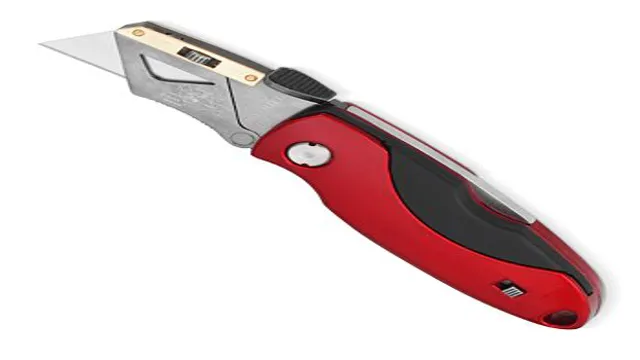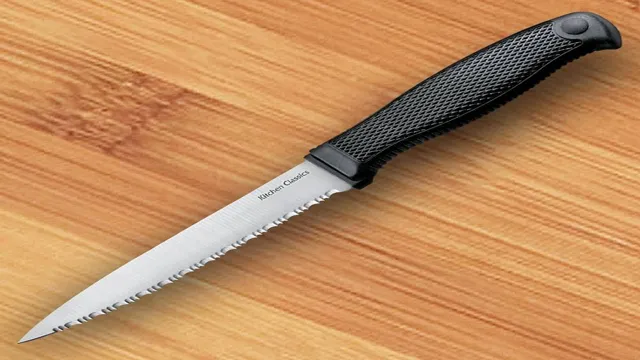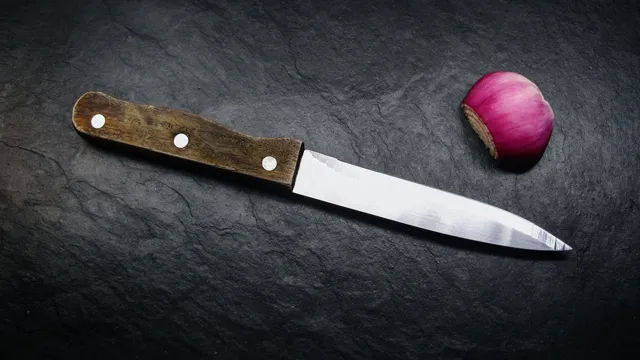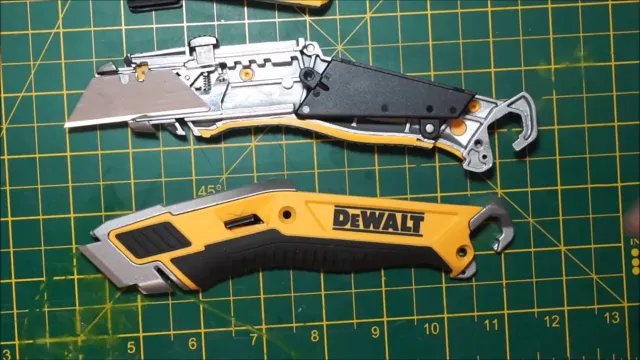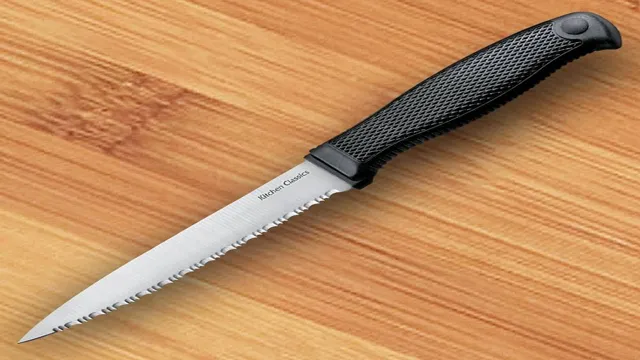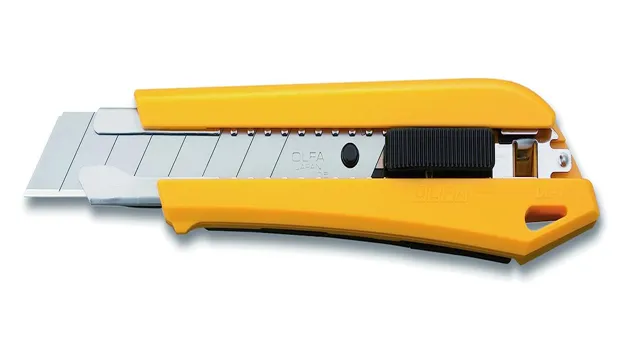What is a Utility Knife For and How to Use It Effectively: A Comprehensive Guide

Do you ever find yourself struggling to cut through tough materials with a dull kitchen knife? Or needing to make precise cuts on a variety of surfaces? If so, it’s time to invest in a quality utility knife. A utility knife, also known as a box cutter or a razor knife, is a versatile tool that can handle a variety of tasks. In this blog, we’ll take a look at what a utility knife is, the different types available, and how to use one like a pro.
So, if you’re tired of fumbling around with blunt kitchen knives, read on for all the information you need to upgrade your cutting game.
Understanding the Utility Knife
Utility knives are a must-have tool for anyone, whether you’re a professional carpenter or just enjoy DIY projects around the house. But what exactly is a utility knife for? Essentially, a utility knife is a versatile cutting tool that can be used for a wide variety of tasks. From cutting boxes open to trimming wallpaper and even carving intricate designs, a utility knife is perfect for all sorts of jobs.
Additionally, utility knives have replaceable blades, allowing you to keep working without the need for constant sharpening. So whether you’re looking to slice through tough materials or simply need a reliable cutting tool, a utility knife is an essential tool to have in your arsenal.
Definition of a Utility Knife
A utility knife is a versatile tool that can cut through various materials such as paper, cardboard, plastic, and even tougher items like ropes or wires. Its design includes a sharp blade for precision cutting and a comfortable handle for easy gripping. With its small size and compact shape, a utility knife can fit easily into a pocket or a tool belt, making it convenient for DIY projects and other tasks that require quick and precise cuts.
It’s an essential tool for many tradespeople, such as electricians, plumbers, and carpenters, who need a reliable cutting tool to navigate through various materials during their work. Whether you’re a professional tradesperson or a DIY enthusiast, a utility knife can make your cutting tasks quicker, safer, and more efficient.

Types of Utility Knives
Utility knives are incredibly versatile tools that find use in many areas of work and life. Understanding the different types of utility knives available in the market can help you choose one that caters to your specific needs and makes your tasks more efficient. Some popular examples of utility knives include the fixed blade, retractable, folding, and snap-off blade knives.
Each of these knives has its own unique benefits, depending on the type of work you perform. Fixed blade knives offer maximum strength and durability, whereas retractable knives come with adjustable blades that can be easily retracted to ensure safety. Folding knives are extremely portable and easy to carry around, while snap-off blades are great for precision cutting.
Overall, picking the right type of utility knife is important for completing your work safely, efficiently, and with maximum precision and accuracy.
Uses for a Utility Knife
A utility knife is a versatile cutting tool that can be used for various tasks in different settings. It is a must-have tool in the toolbox of any DIY enthusiast, carpenter, or homeowner. One of the main uses of a utility knife is for cutting through materials like rope, tape, cardboard, and even carpet.
It can also be used for scoring and marking precise lines on surfaces such as wood or drywall, making it an ideal tool for construction projects. In addition, a utility knife can be used for opening boxes or packages, which makes it a valuable item for anyone in the shipping or delivery business. Whether you need to trim your garden plants or make quick repairs around the house, a utility knife is an essential tool that can help you get the job done effectively and efficiently.
So, the next time you’re wondering what is a utility knife for, remember that it has numerous uses, and it’s a handy tool that you can use in many situations.
Cutting and Slicing
A utility knife is a versatile cutting tool suitable for a wide range of applications. It is commonly used by chefs, carpenters, and even outdoor enthusiasts for cutting and slicing tasks. The knife’s compact size and sharp blade make it ideal for cutting through tough materials such as cardboard, vinyl, and leather.
It is also useful for trimming and cutting wire, cables, and ropes. The serrated versions of a utility knife can be used to cut through tough pieces of bread, fruits, and vegetables. With its ergonomic handle and lightweight design, it is easy to maneuver and control, making it a staple tool in any toolkit.
It can be used for various home improvement projects, DIY tasks, and household chores without compromising precision or accuracy. In conclusion, the utility knife’s versatility, portability, and effectiveness make it an essential tool for professionals and non-professionals alike.
Opening Packages and Boxes
Opening Packages and Boxes can be a tedious task, but with a trusty utility knife, it can be a breeze. This versatile tool can be used for a variety of tasks, from slicing through tough outer packaging to cutting open boxes without damaging what’s inside. The sharp, retractable blade is perfect for cutting through tape, plastic wrap, and even thick cardboard.
Plus, the ergonomic design makes it easy to grip and control, reducing the risk of accidents. Whether you’re moving into a new home and need to slice through tape on boxes or you receive a lot of packages at work, a utility knife is a must-have tool. Don’t struggle with scissors or other ineffective cutting tools – invest in a quality utility knife and make quick work of any packaging or box you come across.
Trimming and Shaving
Utility Knife A utility knife can be an essential tool for trimming and shaving tasks. The sharp blades can cut through materials like foam, fabric, and vinyl with ease. It’s the perfect tool for trimming carpet edges after installation or shaving excess foam from a cushion.
A utility knife can also be used to shave wood edges or trim excess plastic from a new model kit. The sharp blade is versatile and can be used for a variety of tasks around the home or garage. With the right blade and technique, it’s even possible to use a utility knife for grooming tasks like shaping and trimming hair or shaving facial hair.
Overall, a utility knife is an inexpensive yet valuable tool that can come in handy for a wide range of tasks.
Choosing the Right Utility Knife
If you’re wondering what a utility knife is for, it’s essentially a versatile cutting tool that can be used for a variety of tasks. From cutting boxes and opening packages to slicing through foam and trimming materials, a utility knife is an indispensable tool for DIY projects, household chores, and professional use. When choosing the right utility knife, it’s important to consider the size, shape, and blade material.
You’ll want a knife that feels comfortable in your hand, has a sturdy handle, and features a sharp blade that can endure heavy use. Additionally, some utility knives come with retractable blades for safety, while others have fixed blades for added durability. Regardless of your needs, there’s a utility knife out there that can help you get the job done.
So, the next time you’re faced with a cutting task, reach for your trusty utility knife and let it do the hard work for you!
Blade Material
When it comes to choosing the perfect utility knife, one of the most important factors to consider is the blade material. Different materials offer varying levels of durability, sharpness, and corrosion resistance, so it’s important to select the option that best suits your needs. Some of the most popular blade materials include high-carbon stainless steel, ceramic, and titanium.
High-carbon stainless steel is a classic choice that offers excellent edge retention and easy sharpening, while ceramic is known for its unparalleled sharpness and resistance to wear and tear. Titanium blades are incredibly strong and resistant to corrosion, making them a popular choice for outdoor and marine use. Ultimately, the right blade material for you will depend on your specific needs and preferences.
Consider what tasks you’ll primarily be using your utility knife for, as well as your budget, and select a blade material that meets those needs.
Grip Material
When choosing a utility knife, one aspect to consider is the grip material. Since you’ll be using a utility knife for various tasks, it’s important to have a comfortable and secure grip to avoid accidents. Different grip materials offer different levels of comfort and grip.
Rubber grips are popular as they provide a non-slip surface that feels soft in the hand. However, some people may find rubber grips too bulky, especially for finer tasks. Plastic grips are often used as they offer a slim and ergonomic design that is easy to handle.
You may also want to consider a textured grip, which provides additional friction that helps with grip and control. Ultimately, it’s important to consider the tasks you’ll be performing and what grip material will be best suited for your needs. When choosing a utility knife, look for a grip that is comfortable, secure, and meets your personal preferences.
Conclusion
In short, a utility knife is the superhero of the kitchen. It can slice through a ripe tomato, chop up a tough chicken breast, and even tackle the dreaded clamshell packaging. So whether you’re a seasoned chef or just starting out in the kitchen, a utility knife is the trusty sidekick you need in your culinary adventures.
“
FAQs
What are the main uses of a utility knife?
A utility knife is a versatile cutting tool that can be used for a variety of tasks, including opening boxes, cutting cardboard, slicing through plastic packaging, trimming wood and drywall, and even carving.
What is the difference between a utility knife and a pocket knife?
While both a utility knife and a pocket knife are portable cutting tools, a utility knife usually has a retractable blade and a longer handle for more leverage and control, while a pocket knife typically has a folding blade and a smaller size for ease of carrying.
How do you use a utility knife safely?
To use a utility knife safely, always make sure the blade is locked in place and fully extended, use a sharp blade to avoid slip-ups and cuts, wear gloves and eye protection if necessary, and always cut away from your body and other people.
Can a utility knife be used for food prep?
While a utility knife can technically be used for food prep, it is not recommended as the blade may harbor bacteria and other contaminants if not properly sanitized. It is better to use a dedicated kitchen knife with a stainless steel blade for food prep tasks.
What types of blades are available for a utility knife?
There are a variety of blades available for a utility knife, including standard straight blades, serrated blades for cutting through tough materials like rope or fabric, hooked blades for cutting carpet and vinyl flooring, and curved blades for precision cutting and detailing.
Can a utility knife be sharpened?
Yes, a utility knife can be sharpened using a sharpening stone, honing rod, or electric sharpener. It is important to follow the manufacturer’s instructions and use the appropriate angle and pressure to avoid damaging the blade.
What are some common brands of utility knives?
There are many brands of utility knives available on the market, including Stanley, Milwaukee, Husky, DeWalt, and Klein Tools, among others. It is important to choose a trusted brand with a reputation for quality and durability.

